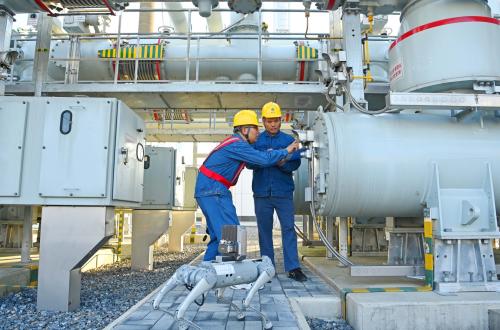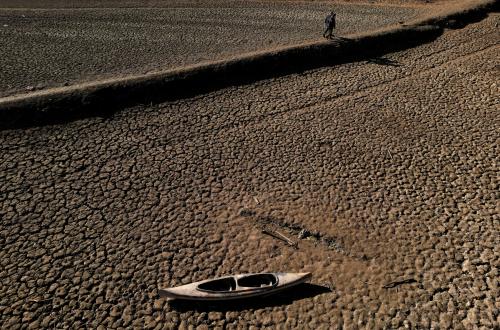Ukrainian President Petro Poroshenko today in Brussels signed the association agreement with the European Union. The signing is a milestone. Whether history records June 27 as Ukraine’s “most important day” since it regained independence in 1991—as Mr. Poroshenko suggested—remains to be seen. Much depends on implementation of the agreement.
The European Union wants stability on its borders. It can use the association agreement to help Ukraine build a more robust economy and democratic institutions. But EU officials will have to devote constant attention and resources to make that a reality.
For Russia, the association agreement is a setback, as it puts Ukraine on a course toward Europe … and out of Moscow’s geopolitical orbit. Will the Kremlin reconcile itself to that? It can make implementation of the agreement and Mr. Poroshenko’s job in general very difficult.
Ukraine
The association agreement can be a game-changer for Ukraine. It includes a deep and comprehensive free trade arrangement (DCFTA) that will open much of the European market to Ukrainian exports. Implementation of the agreement will not only bring Ukraine’s trade and customs rules into conformity with EU standards, it will help the country draw closer to EU democratic norms and “Europeanize” other Ukrainian regulatory regimes.
The association agreement lacks a membership perspective but nevertheless is sweeping. In a private meeting in 2013, the foreign minister of a Central European member of the European Union said that, if Ukraine fully implements the association agreement, it will be “more ready for membership than my country was when it joined in 2004.”
Getting to signature took Kyiv years. Former President Victor Yanukovych supported the association agreement and made some tough decisions in 2010-2011 that enabled the agreement to be completed and initialed in 2012. Ironically, Mr. Yanukovych reversed course in November 2013 and held off on signature, triggering large pro-European demonstrations in Kyiv. Those evolved into broader protests against Mr. Yanukovych’s corruption and authoritarianism, and he fled the country in late February.
Implementation of the association agreement poses challenges for Ukraine. The DCFTA will entail some economic dislocation in the near term, as it also broadens access to Ukraine’s market for EU exporters. But the competition will help Ukrainian companies become more efficient. Most economists predict that the agreement will have a significant positive effect on Ukraine’s gross domestic product.
Implementation of agreements, unfortunately, has not always been Kyiv’s strong suit (look at the history of suspended IMF programs over the past 20 years). But it may be that Mr. Poroshenko, Acting Prime Minister Arseniy Yatseniuk and others in the cabinet and parliament get it: Ukraine has a rare second chance after the missed opportunity of the 2004 Orange Revolution to put itself on a course to becoming a modern European country, just as neighboring Poland has done.
The government should be helped by the fact that drawing closer to the European Union is popular in the parliament and the broad public. Public support for the European course appears to have increased as a consequence of Russia’s illegal seizure of Crimea and pressure on Kyiv.
European Union
For the European Union, signature of the association agreement with Ukraine (as well as signature of similar pacts with Georgia and Moldova) represents a significant step forward in its Eastern Partnership policy. But signature does not end the story. EU officials will now need to provide loads of technical assistance and resources to help Ukraine implement the agreement. (The U.S. government should shape its assistance programs in ways that will help Kyiv with implementation.)
The European Union will need to be sensitive to near-term effects of the DCFTA, to ensure that the impact of dislocation does not fall too hard on the Ukrainian economy. One relatively painless step that EU countries can take would be to grant Ukrainian citizens visa-free travel.
While implementation of the association agreement will require EU attention, time and resources, it offers a big pay-off: a stable Ukraine with a growing economy and stronger democratic institutions is exactly the kind of country that the European Union wants as a neighbor.
Russia
For the Kremlin, signature of the Ukraine-EU association agreement represents a setback. Vladimir Putin last December offered $15 billion in loans, with no overt strings attached, and a huge gas price cut to turn Ukraine away from signing.
It is difficult to escape the conclusion that Moscow’s actions since late February have aimed to destabilize the government in Kyiv and slow its path toward the European Union. The acting government that took office following Mr. Yanukovych’s departure immediately made clear the priority it attached to signing the association agreement. Within days, Russian forces seized Crimea, customs officials began blocking some Ukrainian exports to Russia, and Gazprom raised the price of the gas. “Little green men”—the term Ukrainians used to describe the soldiers in Crimea without identifying insignia whom Mr. Putin later admitted were Russian—began to turn up in the eastern Ukrainian regions of Donetsk and Luhansk.
Can Moscow now reconcile itself to the association agreement? A Russian deputy foreign minister warned of “serious consequences” but conceded that signing such a document was “a sovereign right of any state.” Mr. Putin’s spokesman said Moscow would take steps to avoid any negative impact on the Russian economy.
To be sure, Russia has legitimate interests at stake. Kyiv appears ready for a dialogue on minimizing the impact of the association agreement on Ukrainian-Russian trade. But will that satisfy Moscow?
That is a key question. Russia has significant influence over the armed separatists in Donetsk and Luhansk, many of whom are Russian citizens, and has other leverage over Ukraine. Russia can use that influence and leverage to promote a ceasefire and a settlement, if it wants to. If Moscow instead chooses to continue its efforts to destabilize Ukraine, that will immensely complicate implementation of the Ukraine-EU association agreement.
Today is a good day for Ukraine, opening new potential for its European course. We will now see how fast it can proceed down that path, and how much others will help—or hinder—it.
The Brookings Institution is committed to quality, independence, and impact.
We are supported by a diverse array of funders. In line with our values and policies, each Brookings publication represents the sole views of its author(s).



Commentary
Poroshenko Signs EU-Ukraine Association Agreement
June 27, 2014